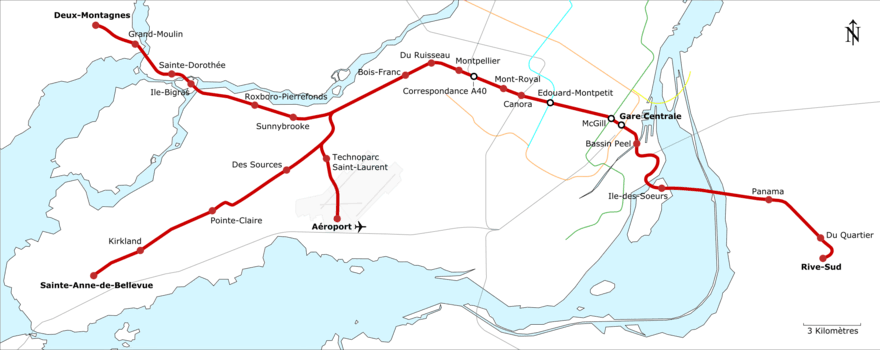Réseau express métropolitain
The Réseau express métropolitain (REM; English: Metropolitan Express Network; previously known as Réseau électrique métropolitain) is a light metro rapid transit system under construction in the Greater Montreal area around Montreal, Quebec, Canada. The system will link several suburbs with Downtown Montreal via Central Station. It involves the conversion of the existing Deux-Montagnes commuter rail line to light metro standards. A station at Montréal–Trudeau International Airport will serve as the terminus of one of the four branches.
 | |||||||||||||||||||||||||||||||||||||||||||||||||||||||||||||||||||||||||||||||||||||||||||||||||||||||||||||||||||||||||||||||||||||||||||||||||||||||||||||||||||||||||||||||||||||||||||||||||||||||||||||||||||||||||||||||||||||||||||||||||||||||||||||||||||||||||||||||||||||||||||
| Overview | |||||||||||||||||||||||||||||||||||||||||||||||||||||||||||||||||||||||||||||||||||||||||||||||||||||||||||||||||||||||||||||||||||||||||||||||||||||||||||||||||||||||||||||||||||||||||||||||||||||||||||||||||||||||||||||||||||||||||||||||||||||||||||||||||||||||||||||||||||||||||||
|---|---|---|---|---|---|---|---|---|---|---|---|---|---|---|---|---|---|---|---|---|---|---|---|---|---|---|---|---|---|---|---|---|---|---|---|---|---|---|---|---|---|---|---|---|---|---|---|---|---|---|---|---|---|---|---|---|---|---|---|---|---|---|---|---|---|---|---|---|---|---|---|---|---|---|---|---|---|---|---|---|---|---|---|---|---|---|---|---|---|---|---|---|---|---|---|---|---|---|---|---|---|---|---|---|---|---|---|---|---|---|---|---|---|---|---|---|---|---|---|---|---|---|---|---|---|---|---|---|---|---|---|---|---|---|---|---|---|---|---|---|---|---|---|---|---|---|---|---|---|---|---|---|---|---|---|---|---|---|---|---|---|---|---|---|---|---|---|---|---|---|---|---|---|---|---|---|---|---|---|---|---|---|---|---|---|---|---|---|---|---|---|---|---|---|---|---|---|---|---|---|---|---|---|---|---|---|---|---|---|---|---|---|---|---|---|---|---|---|---|---|---|---|---|---|---|---|---|---|---|---|---|---|---|---|---|---|---|---|---|---|---|---|---|---|---|---|---|---|---|---|---|---|---|---|---|---|---|---|---|---|---|---|---|---|---|---|---|---|---|---|---|---|---|---|---|---|---|---|---|---|---|---|---|
| Owner | CDPQ Infra | ||||||||||||||||||||||||||||||||||||||||||||||||||||||||||||||||||||||||||||||||||||||||||||||||||||||||||||||||||||||||||||||||||||||||||||||||||||||||||||||||||||||||||||||||||||||||||||||||||||||||||||||||||||||||||||||||||||||||||||||||||||||||||||||||||||||||||||||||||||||||||
| Locale | Greater Montreal | ||||||||||||||||||||||||||||||||||||||||||||||||||||||||||||||||||||||||||||||||||||||||||||||||||||||||||||||||||||||||||||||||||||||||||||||||||||||||||||||||||||||||||||||||||||||||||||||||||||||||||||||||||||||||||||||||||||||||||||||||||||||||||||||||||||||||||||||||||||||||||
| Transit type | Light metro | ||||||||||||||||||||||||||||||||||||||||||||||||||||||||||||||||||||||||||||||||||||||||||||||||||||||||||||||||||||||||||||||||||||||||||||||||||||||||||||||||||||||||||||||||||||||||||||||||||||||||||||||||||||||||||||||||||||||||||||||||||||||||||||||||||||||||||||||||||||||||||
| Number of lines | 1 (3 branches) | ||||||||||||||||||||||||||||||||||||||||||||||||||||||||||||||||||||||||||||||||||||||||||||||||||||||||||||||||||||||||||||||||||||||||||||||||||||||||||||||||||||||||||||||||||||||||||||||||||||||||||||||||||||||||||||||||||||||||||||||||||||||||||||||||||||||||||||||||||||||||||
| Number of stations | 26 | ||||||||||||||||||||||||||||||||||||||||||||||||||||||||||||||||||||||||||||||||||||||||||||||||||||||||||||||||||||||||||||||||||||||||||||||||||||||||||||||||||||||||||||||||||||||||||||||||||||||||||||||||||||||||||||||||||||||||||||||||||||||||||||||||||||||||||||||||||||||||||
| Daily ridership | 190,000 (projected)[1] | ||||||||||||||||||||||||||||||||||||||||||||||||||||||||||||||||||||||||||||||||||||||||||||||||||||||||||||||||||||||||||||||||||||||||||||||||||||||||||||||||||||||||||||||||||||||||||||||||||||||||||||||||||||||||||||||||||||||||||||||||||||||||||||||||||||||||||||||||||||||||||
| Website | rem | ||||||||||||||||||||||||||||||||||||||||||||||||||||||||||||||||||||||||||||||||||||||||||||||||||||||||||||||||||||||||||||||||||||||||||||||||||||||||||||||||||||||||||||||||||||||||||||||||||||||||||||||||||||||||||||||||||||||||||||||||||||||||||||||||||||||||||||||||||||||||||
| Operation | |||||||||||||||||||||||||||||||||||||||||||||||||||||||||||||||||||||||||||||||||||||||||||||||||||||||||||||||||||||||||||||||||||||||||||||||||||||||||||||||||||||||||||||||||||||||||||||||||||||||||||||||||||||||||||||||||||||||||||||||||||||||||||||||||||||||||||||||||||||||||||
| Operation will start | 2021 (first section from Brossard to Central Station) | ||||||||||||||||||||||||||||||||||||||||||||||||||||||||||||||||||||||||||||||||||||||||||||||||||||||||||||||||||||||||||||||||||||||||||||||||||||||||||||||||||||||||||||||||||||||||||||||||||||||||||||||||||||||||||||||||||||||||||||||||||||||||||||||||||||||||||||||||||||||||||
| Operator(s) | SNC-Lavalin–Alstom | ||||||||||||||||||||||||||||||||||||||||||||||||||||||||||||||||||||||||||||||||||||||||||||||||||||||||||||||||||||||||||||||||||||||||||||||||||||||||||||||||||||||||||||||||||||||||||||||||||||||||||||||||||||||||||||||||||||||||||||||||||||||||||||||||||||||||||||||||||||||||||
| Number of vehicles | 212 Alstom Metropolis[2] | ||||||||||||||||||||||||||||||||||||||||||||||||||||||||||||||||||||||||||||||||||||||||||||||||||||||||||||||||||||||||||||||||||||||||||||||||||||||||||||||||||||||||||||||||||||||||||||||||||||||||||||||||||||||||||||||||||||||||||||||||||||||||||||||||||||||||||||||||||||||||||
| Technical | |||||||||||||||||||||||||||||||||||||||||||||||||||||||||||||||||||||||||||||||||||||||||||||||||||||||||||||||||||||||||||||||||||||||||||||||||||||||||||||||||||||||||||||||||||||||||||||||||||||||||||||||||||||||||||||||||||||||||||||||||||||||||||||||||||||||||||||||||||||||||||
| System length | 67 km (42 mi)[3] | ||||||||||||||||||||||||||||||||||||||||||||||||||||||||||||||||||||||||||||||||||||||||||||||||||||||||||||||||||||||||||||||||||||||||||||||||||||||||||||||||||||||||||||||||||||||||||||||||||||||||||||||||||||||||||||||||||||||||||||||||||||||||||||||||||||||||||||||||||||||||||
| Track gauge | 1,435 mm (4 ft 8 1⁄2 in) standard gauge | ||||||||||||||||||||||||||||||||||||||||||||||||||||||||||||||||||||||||||||||||||||||||||||||||||||||||||||||||||||||||||||||||||||||||||||||||||||||||||||||||||||||||||||||||||||||||||||||||||||||||||||||||||||||||||||||||||||||||||||||||||||||||||||||||||||||||||||||||||||||||||
| Electrification | 1500 V DC overhead | ||||||||||||||||||||||||||||||||||||||||||||||||||||||||||||||||||||||||||||||||||||||||||||||||||||||||||||||||||||||||||||||||||||||||||||||||||||||||||||||||||||||||||||||||||||||||||||||||||||||||||||||||||||||||||||||||||||||||||||||||||||||||||||||||||||||||||||||||||||||||||
| Top speed | 100 km/h (62 mph) | ||||||||||||||||||||||||||||||||||||||||||||||||||||||||||||||||||||||||||||||||||||||||||||||||||||||||||||||||||||||||||||||||||||||||||||||||||||||||||||||||||||||||||||||||||||||||||||||||||||||||||||||||||||||||||||||||||||||||||||||||||||||||||||||||||||||||||||||||||||||||||
| |||||||||||||||||||||||||||||||||||||||||||||||||||||||||||||||||||||||||||||||||||||||||||||||||||||||||||||||||||||||||||||||||||||||||||||||||||||||||||||||||||||||||||||||||||||||||||||||||||||||||||||||||||||||||||||||||||||||||||||||||||||||||||||||||||||||||||||||||||||||||||
The 67-kilometre (42 mi) light metro rail system is projected to cost CA$6.5 billion. It would be independent of—but connected to—the existing Montreal Metro, operated by the STM. Trains on the network are expected to be fully automated and driverless, and it would become the fourth longest automated transportation system in the world, after the Singapore Mass Rapid Transit, Vancouver SkyTrain, and Dubai Metro.[4]
History
On 13 January 2015, Quebec Premier Philippe Couillard and Michael Sabia, CEO of Caisse de dépôt et placement du Québec (CDPQ), agreed to a partnership in which the Crown corporation could assume financing for major transportation projects in the province, with $7.4 billion planned to be spent on infrastructure from 2014 to 2024.
On 22 April 2016, Sabia and Montreal Mayor Denis Coderre unveiled the project, then known as the Réseau électrique métropolitain, to the media. A completion date for a first portion of the system was put forward for December 2020. On 22 June 2016, CDPQ Infra published two requests for qualification: one for the engineering, procurement and construction contract and the other for the rolling stock, systems, operation, and maintenance. The estimated value of the two contracts are $4 billion and $1.5 billion respectively.[5]
On 25 November 2016, CDPQ Infra announced the addition of three new stations to the project. The Central Station, McGill, and Édouard-Montpetit stations will significantly improve downtown Montreal service, and further integrate the REM into the Metro system through fluid and efficient connections to the Orange, Green and Blue lines. The announcement will adjust the price tag of the entire project to a total $5.9 billion.[6][7]
On 15 June 2017, the Government of Canada pledged $1.28 billion to finance the project,[8] thus completely securing the financial portion of the REM. On the same day, Sabia announced that construction on the project was to start at the end of 2017. On 1 December 2017, the CDPQ extended the tender process on the project to the end of January 2018, citing a need for additional discussions with the bidders.[9]
.jpg)
Procurement
On 28 June 2016, CDPQ Infra launched two public tenders in parallel: one for "Engineering, Procurement and Construction" (EPC, or "Ingénierie, Approvisionnement et Construction des infrastructures" (IAC) in French), and a second, for "Rolling Stock, Systems and Operation and Maintenance Services" (RSSOM, or "Fourniture du Matériel Roulant, de Systèmes de conduite automatique et de Services d'Exploitation et de Maintenance" (MRSEM) in French).[10][11] Following a prequalification phase, the Caisse's subsidiary announced, on 10 November 2016, the qualified candidates that would be allowed to submit a bid:
- For the EPC contract, the competitors were the Groupe NouvLR consortium composed of SNC-Lavalin Grands Projets, Dragados, Aecon, Pomerleau, EPC and AECOM and the Kiewit-Eurovia consortium formed by Kiewit Corporation, Eurovia, WSP Global and Parsons Corporation;[12][13]
- For the RSSOM contract, three companies and consortia were in competition: Bombardier Transportation alone, Alliance Montréal Mobilité (composed of Parsons Corporation, Hyundai Rotem, RATP Dev and Thales Canada) and the Groupe des Partenaires pour la Mobilité des Montréalais (associating Alstom and SNC-Lavalin O&M).[12] Ansaldo STS-Hitachi and China Railway International Co. were not allowed to bid.[12]
According to the media, the final bids were submitted to CDPQ Infra on 27 October 2017.[14] On 10 November 2017, the date of the planned announcement of the selected contractors, the procurement process was "postponed indefinitely," according to the Caisse's subsidiary, to provide more time for the analysis and evaluation of the bids received.[15] On 8 February 2018, CDPQ Infra finally announced its selection: Groupe NouvLR consortium for the EPC contract (SNC-Lavalin Grands Projets, Dragados, Aecon, Pomerleau, EBC and AECOM) and the Groupe des Partenaires pour la Mobilité des Montréalais for the RSSOM contract (Alstom and SNC-Lavalin O&M).[13][16] The contracts' value is estimated to be around $6.3 billion, out of which approximately 80% account for the EPC contract.[17]
Route
The primary route is based around the Mount Royal Tunnel, where new underground stations are being built to connect with the existing McGill and Édouard-Montpetit Metro stations. New connections with commuter rail will be built near the A-40 to the Mascouche line.
Southeast from Central Station, the line will follow existing rail lines past Cité du Havre and across to Nuns' Island and then use a rail deck constructed on the new Champlain Bridge to cross the St. Lawrence. Three stations in Brossard on the South Shore are being built: Panama, Du Quartier (for the DIX30 commercial district), and Rive-Sud; and one station, Chevrier, is part of future plans.
The northwest branch will be a direct conversion of the existing Deux-Montagnes line, with the doubling of the tracks beyond Bois-Franc station. On the West Island, new branch routes off the northwest branch will begin near the A-13, with the airport branch making a stop in Technoparc St-Laurent before terminating at Montréal–Pierre Elliott Trudeau International Airport and the other branch will follow an existing rail corridor through Pointe-Claire and Kirkland before it ends in Sainte-Anne-de-Bellevue.
In the city centre, three stations are being built to interconnect with existing Metro lines; McGill will connect with the Green Line,[7] Édouard-Montpetit will connect with the Blue Line,[7] and Bonaventure Gare Centrale will connect with the Orange Line.

Stations
The REM will consist of 26 stations on three branches. Twelve of these stations are currently on the Deux-Montagnes line and will become part of the REM after being converted to rapid transit standards. Several have received new names since the project's inception.[20]
South Shore and Central section (all branches)
| Station | Opening for REM | Opened | Parking spots | Connections |
|---|---|---|---|---|
| Brossard | 2021 | N/A | Unknown | RTL, Exo |
| Du Quartier | 2021 | None[21] | RTL | |
| Panama | 2021 | Unknown | Terminus Brossard-Panama; RTL and Exo | |
| Île-des-Soeurs | 2021 | None | STM | |
| Griffintown–Bernard-Landry | 2023 | None | STM | |
| Central Station | 2021 | 1943 | None | Downtown Terminus (Terminus RTL), Société de transport de Montréal (STM) 150, 355, 358, 410, 430, 465, 480 (Express), 715, 747 (Express), 36, 61, 168, 420 (on University Street), 74 (on rue de la Gauchetière), 107 (on Peel Street)[22] |
| McGill | 2022 | 1966 | None | |
| Édouard-Montpetit | 2022 | 1988 | None | |
| Canora | 2022 | 1918 | None | STM 92 on Jean Talon Street, 160 (less than 200 metres or 220 yards south at Wilderton Ave. / Bates Rd. east bound & Wilderton Ave. / Barclay St. west bound[23]), 372 on Jean Talon Street |
| Ville-de-Mont-Royal | 2022 | 1918 | None | STM 16, 119, 165, 435 |
| Côte-de-Liesse | 2022 | N/A | None | |
| Montpellier | 2022 | 1918 | None | STM |
| Du Ruisseau | 2022 | 1994 | 1,060 | STM, STL |
| Bois-Franc | 2023 | 1994 | 740 | STM, STL |
Deux-Montagnes branch
| Station | Opening for REM | Opened | Parking spots | Connections |
|---|---|---|---|---|
| Sunnybrooke | 2023 | 1994 | 400 | STM |
| Pierrefonds-Roxboro | 2023 | 1944 | 1,140 | STM |
| Île-Bigras | 2023 | 1995 | 45 | STL (taxibus only) |
| Sainte-Dorothée | 2023 | 1995 | 975 | STL |
| Grand-Moulin | 2023 | 1925[24] | 304[25] | Exo |
| Deux-Montagnes | 2023 | 1995 | 1,256[26] | Exo |
Airport branch
| Station | Planned opening | Parking spots | Connections |
|---|---|---|---|
| Marie-Curie | 2023 | None | Unknown |
| YUL–Montréal–Trudeau Airport | 2023 | None | Connection to Montréal–Pierre Elliott Trudeau International Airport STM |
Sainte-Anne-de-Bellevue branch
| Station | Planned opening | Parking spots | Connections |
|---|---|---|---|
| Des Sources | 2023 | 500 | STM |
| Fairview–Pointe-Claire | 2023 | 700 | STM |
| Kirkland | 2023 | 2,500 | STM |
| L'Anse-à-l'Orme | 2023 | 200 | STM, Exo |
Controversies
In a report prepared by the Bureau d'audiences publiques sur l'environnement (BAPE) and released on 20 January 2017, the project was criticized. In the words of journalist Denis Lessard, "the BAPE poured cold water" on the project.[27]
Notably, the BAPE pointed to a lack of crucial information being provided on the project's financial model, environmental impact, and impact on ridership levels throughout public transit networks around Montreal. Without such information, the BAPE declared that it was "premature to authorize the realization of this project".[28]
The BAPE also estimated that CDPQ Infra did not meet its obligations for transparency, as it had failed to provide information in a timely fashion on the ridership levels of the REM's three antennaes (route branches).[28]
The CDPQ Infra was also reproached for not studying the impact of the REM on existing public transit authorities.[28] CDPQ Infra was criticized for not being able to answer questions like how much tickets would cost, whether municipalities on the REM would themselves have to pay for the necessary infrastructure for access to it, and whether municipalities also have to contribute to the REM's operation.[28]
A lawsuit filed by Coalition Climat further alleged that the REM project violated federalism for a lack of federal assessment that harmed citizens' environmental rights by contributing to noise pollution and urban heat islands. The lawsuit was dismissed by the Quebec Superior Court on 13 December 2017.[29]
Another controversy occurred in November 2019, when Montreal mayor Valerie Plante proposed naming Griffintown's REM station after controversial politician Bernard Landry, sparking a backlash from the city's Irish community.[30]
Future lines, stations and extensions
On May 20, 2019, the Quebec provincial government announced that they had requested CDPQi to study two REM extensions. The government had also made a request to determine the best electrical transit system to be put in place for the Montreal East Island, with the possibility of it being a new REM line.[31] The federal government also requested the Canadian Infrastructure Bank study a possible extension of the REM to Dorval train station.[32] The city of Montreal requested two stations instead of one station at Bassin Peel.[33] Mayor Valérie Plante announced funding for the West branch of the "Pink Line".[34] This branch would be a continuation of a REM line, if it is the technology chosen by the CPDQi.
Laval branch
The REM would be extended nearly 20 kilometres (12 mi) to Carrefour Laval from Du Ruisseau station.
Chambly extension
The REM would be extended nearly 30 kilometres (19 mi) to Chambly and St-Jean-sur-Richelieu from Rive-Sud station.
Dorval station
An extra station would be added at the Dorval train station to connect with Exo and Via Rail trains. This station would be about a 1-kilometre (0.62 mi) extension from the Airport station.
Pointe-Saint-Charles station
This station would replace, along with the Griffintown station, the previously planned Bassin Peel station.
East Island line
This line would start in Downtown Montreal and follow Notre-Dame Street, then split into two branches, one heading to Pointe-aux-Trembles and one heading to CÉGEP Marie-Victorin, connecting to the STM's Green line at Radisson station and to the STM's Blue line at a future Anjou station.
Lachine "Pink Line West" branch
If the REM technology is chosen, this branch would connect Lachine to Downtown Montréal to the East Island line.
References
- "Sommaire des previsions d'achalandage du REM" (PDF). www.cdpqinfra.com. CDPQ Infra Inc. February 2017.
- "Les trains du REM seront construits en Inde" (in French). 12 April 2018. Retrieved 13 April 2018.
- Magder, Jason (22 April 2016). "Electric light-rail train network spearheaded by Caisse de dépôt to span Montreal by 2020". Montreal Gazette. Retrieved 22 April 2016.
- "Réseau électrique métropolitain". cdpqinfra.com. 29 November 2016. Retrieved 29 November 2016.
- Briginshaw, David (30 June 2016). "Tendering starts for Montreal rail project". International Railway Journal. Retrieved 5 July 2016.
- Magder, Jason (25 November 2016). "Three REM train stations added to proposed route through downtown Montreal". Montreal Gazette. Retrieved 25 November 2016.
- Wanek-Libman, Mischa (28 November 2016). "Proposed Montréal REM project grows by three stations and CA$400M". Railway Track & Structures. Simmons-Boardman Publishing Inc.
- "The Government of Canada confirms a $1.28-billion investment in the Réseau électrique métropolitain". www.newswire.ca. Retrieved 20 July 2017.
- "Citing 'value for money', Caisse extends bidding for REM electric-train project". Montreal Gazette. 1 December 2017. Retrieved 7 January 2018.
- "Ingénierie, Approvisionnement et Construction des infrastructures du Réseau Électrique Métropolitain de Montréal" (PDF) (in French). 28 June 2016. Archived from the original (PDF) on 22 August 2016. Retrieved 21 October 2016.
- "Fourniture du Matériel Roulant, de Systèmes et de Services d'Exploitation et de Maintenance du Réseau Électrique Métropolitain de Montréal" (PDF) (in French). 28 June 2016. Archived from the original (PDF) on 23 August 2016. Retrieved 21 October 2016.
- "Appel de qualification : résultats" (PDF) (in French). 10 November 2016. Archived from the original (PDF) on 12 November 2016. Retrieved 11 November 2016.;
- "Main partners". Retrieved 1 March 2018.
- "REM: les offres finales des soumissionnaires déposées aujourd'hui" (in French). 27 October 2017. Retrieved 30 October 2017.
- "REM: le choix des consortiums reporté". 11 November 2017. Retrieved 27 November 2017.
- "REM: les offres finales des soumissionnaires déposées aujourd'hui" (in French). 8 February 2018. Retrieved 8 February 2018.
- "CDPQ Infra awards contracts for Montreal REM". 8 February 2018. Retrieved 9 February 2018.
- "South Shore preparatory work gets underway | REM". rem.info.
- http://news.morningstar.com/all/canada-news-wire/20180411C5798/media-invitation-rseau-express-mtropolitain-official-groundbreaking.aspx
- "Stations". REM. Réseau express métropolitain. Retrieved 13 February 2020.
- https://rem.info/fr/stations
- "Maps". stm.info. Retrieved 20 July 2017.
- "Bus - Schedules". stm.info. Retrieved 20 July 2017.
- "Transit History of the Banlieues de Montreal, Quebec". Retrieved 8 February 2018.
- "Gare Grand-Moulin". RTM.
- RTM. "Gare Deux-Montagnes".
- "Train électrique: le BAPE jette une douche froide sur le projet de la Caisse - Denis Lessard - Politique québécoise". lapresse.ca. 20 January 2017. Retrieved 20 July 2017.
- "Train électrique: un projet prématuré, selon le BAPE - Bruno Bisson - Montréal". lapresse.ca. 21 January 2017. Retrieved 20 July 2017.
- "Challenge of Caisse de dépôt's REM train project rejected by Superior Court". montrealgazette.ca. 13 December 2017. Retrieved 1 January 2018.
- "OTL Blog » Blog Archive » An Open Letter from a City of Montreal Ambassador to Mayor Valerie Plante RE: Griffintown REM Proposal and Negative International Reaction". Retrieved 14 February 2020.
- "Plante fumes as Quebec considers possible expansion of REM | Montreal Gazette". 7 May 2019.
- "Un prolongement du REM pourrait relier la gare de Dorval à l'aéroport". Le Devoir.
- "Bassin Peel: la Ville demande deux stations du REM". La Presse. 31 October 2019.
- https://www.cbc.ca/news/canada/montreal/montreal-lachine-tramway-annoucement-pink-line-1.5190472
